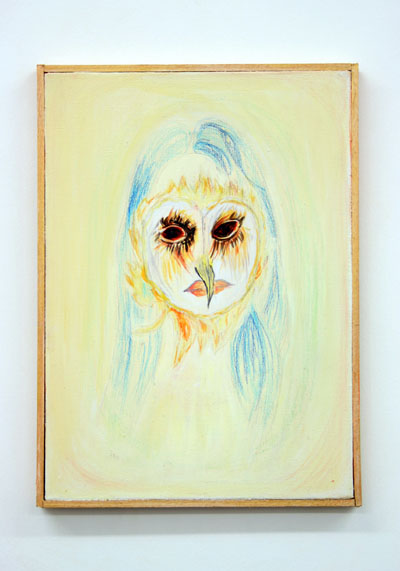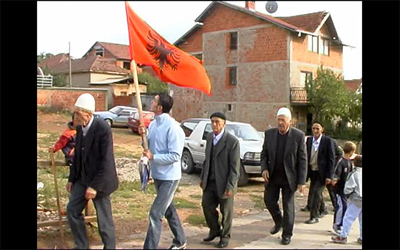
_______________________________________________________________
Jack Duplock, Birdgirl, 2012, acrylic and pencil on canvas, framed
_______________________________________________________________ 
_______________________________________________________________
Gazmend Ejupi, The Wedding, Video still, 2012
_______________________________________________________________
|
__________________________________________
Rainbow House , Gallery 1
Jack Duplock with
Jamie Shovlin, Charles Danby, Paul Johnson and Katie Bonham
Gazmend Ejupi, the Wedding , Gallery 2
Special Event: 27th April 6-9pm,
the Agency and Milton Keynes Gallery Sound Scratch Nights:
Johnny Hill, Ed Simpson, Mimosa Moize
_______________________________________
The Agency is pleased to present a new project by Jack Duplock that continues his ongoing investigation with the subject of folk. The Rainbow House uses the idea of community as its model to bring together a group of artists that in some way reference or touch upon themes of folk.
A particular focus is on the social experiments that occurred in the late sixties and early seventies as a reaction to the mainstream material culture of the time. During the 60s a dissatisfied generation emerged from the wings of counterculture, through radical drug taking hippie rebellion and the far left belief in changing the social structure. Experimenting with the utopian idea of the collective they began to live together as one in a free space. Anything was permissible and possessions and duties were shared. It was also an idea of transient space, a space without metaphorical walls, allowing individuals to break from the considered burdens of attachment.
By the end of the 1960s this hippie utopian dream was becoming a bad trip. As the city became a boiling pot waiting to explode people began to move out and re-unite the tribe in the wilderness, shedding the old skin and embracing the natural one of Mother Earth. They built new communities governed by systems of rules drawn from a mix of Buddhism, paganism and radical social thinking.
The most famous of these communities was Morning Star, that emerged from the remnants of the San Francisco Diggers, a movement that had evolved out of two radical traditions; the bohemian art and theatre scene, and the new left civil rights peace movement. They organised street theatre, anarcho-direct action, and art happenings in their social agenda of creating a free city.
The Rainbow House represents a temporary archive of a fictional community divided through themes. Music - Jamie Shovlin will be showing part of his Lustfaust: A Folk Anthology 1976 -80, a constructed, extensive and seemingly real archive of a fictional German noise band of the 1970s. Exploring the significance of music within communities and the role they have in the myth making of bands that make the music via the distribution of bootleg cassettes. Politics - Charles Danby has recreated an early Morning Star manifesto news flyer, offering it once more for wide and communal consumption. The occult, magic and myth - Paul Johnson will be showing 'Owl', a sculpture assembled from paper. The owl has dual meaning in folklore, both representing wisdom and evil, and alludes to votive icons made specifically by communities as offerings to ward off or attract spirits. Jack Duplock will include alongside a group of totem wall pieces a series of small portraits of characters adorning animal like costumes, evoking the magical bodies worn by shamans to aid them on their mystical journeys but also alluding to the idea of dressing up as a radical political statement, an act prevalent within the counterculture of the sixties and the seventies. Design- Katie Bonham will be showing a group of ceramics that reference designs of the period, in particular from the West German movement Jasba. The show looks to reassess the significance of these alternative communities to contemporary culture today.
communities to contemporary culture today.
Gazmend Ejupi, The Wedding,Two-Screen Video , 2012
The Agency is pleased to present the Kosovan artist Gazmend Ejupi with a two-screen video installation around the rituals and ceremonies of a wedding ceremony near Prishtina, the artist's place of origin. Working in multimedia as well as curatorial practices, Ejupi has been recording habitual life in Prishtina roughly a decade after the atrocities committed there in one of the most shocking wars within contemporary Eastern Europe. His Video works record with humanity and humour ancient rituals preserved as well as common powercuts in the family home and the odd jobs gipsy youth take to make a living.
Recording the minutiae of mostly Kosovan everyday life in Ejupi's work is inexorably linked with the social observations of a resurrected culture after being ruptured by war and ethnic conflict. 'The Wedding' is a detailed recording of the different ritualistic activities of a village wedding. The split screens represent the separate male and female activities required for the ceremony. Using a fly-on-the wall style of filming Ejupi's gaze follows the men during their tea ceremonies, small children sampling cigarettes and the women gathering to dance around the bride. Through the artist' camera we are moved into a world of familial bonding through repetitive and handed down gestures and dress and behavioural codes, which still work to this day to weld together a variety of different characters. Ejupi uses a documentary approach to film-making, adding sound pieces and two-dimensional works to complete his installation.
|
 |